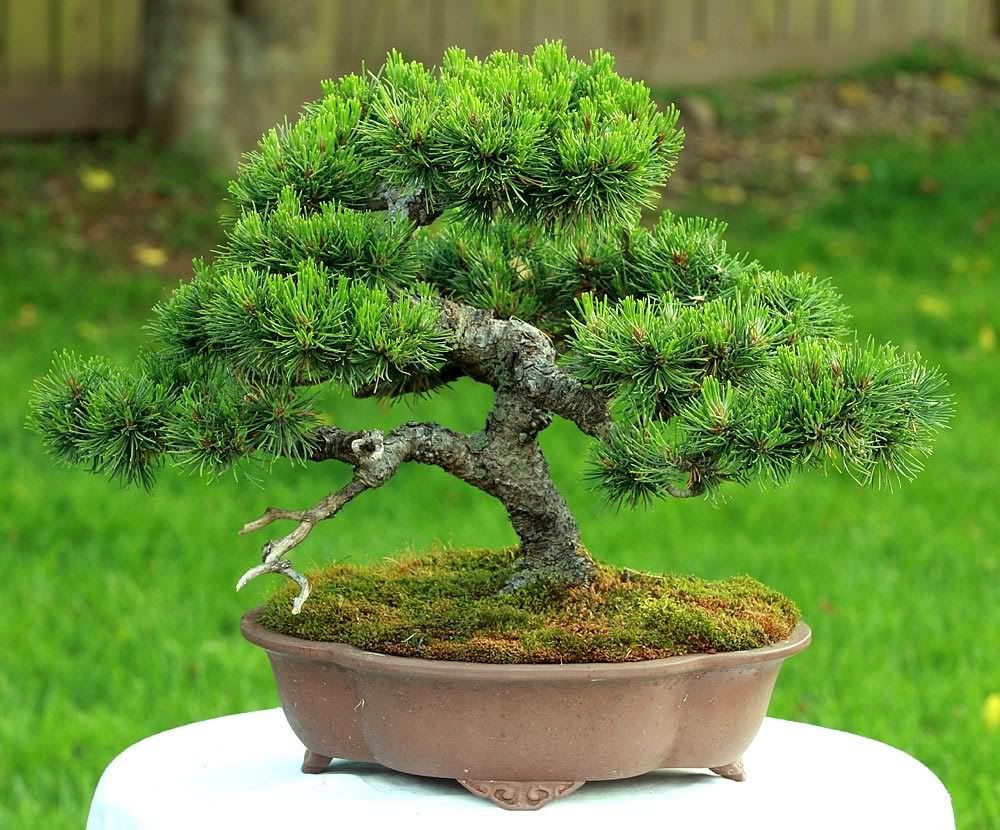Has anyone done anything with a mugo pine? I have several that the deer eat back to nubbins each year, but if there was a go-by to make it look like something in the forest, it might be worth covering with burlap in the fall.
Ideas?
Has anyone done anything with a mugo pine? I have several that the deer eat back to nubbins each year, but if there was a go-by to make it look like something in the forest, it might be worth covering with burlap in the fall.
Ideas?
It can be done, they can be a bit finicky.
You pinch off the buds early in the year. They can be sensitive to repotting or moving.

Wow! That certainly is different. It will take a few years for mine to approach that.
Mine are about half the size of the one in the photo, allowing for being chewed to nubbins each year.

It will take some serious pruning to approach the one in your pic, Greg.
Are we even talking the same bushes. Greg’s seems to be a dwarf variety at the very least. I had one like what you show Steve and I found it to be pretty fast growing and somewhat hard to control. And I wasn’t trying to keep it in scale in a Garden RR.
As far as I know, they are all called “Dwarf Mugo Pine.” Of course, “dwarf,” is a somewhat rubber term.
Steve Featherkile said:
As far as I know, they are all called “Dwarf Mugo Pine.” Of course, “dwarf,” is a somewhat rubber term.
“dwarf” slow growing Mugo Pine
I am in the process of removing my so called “Dwarf” trees and bushes. After 10 years they are too big. Their replacements, (if I decide to replace–a desert plant less landscape looks better and better to me) will be left in their pots. No more in the ground flora for me.
John Bouck said:
I am in the process of removing my so called “Dwarf” trees and bushes. After 10 years they are too big. Their replacements, (if I decide to replace–a desert plant less landscape looks better and better to me) will be left in their pots. No more in the ground flora for me.
That probably makes a lot of sense, JB. Of course, I could just let the deer have their way… (http://www.largescalecentral.com/externals/tinymce/plugins/emoticons/img/smiley-cool.gif)
potted mugo (bonsai) ;
https://www.youtube.com/watch?v=TFjciaxp4J8
There is some text on bud selection here;
http://www.bonsai4me.com/AdvTech/ATMugo%20Pines%20Indepth.htm
Personally leery of the claim “dwarf” mugo pines. Tend to stick with ‘birds nest’ ‘dwarf alberta spruce’ ‘dwarf cedar’ purchased during end of season sales, and all planted into the ground. Usually pruning some of the lower limbs previous to planting…
doug c
The bonsai I showed is about 1-1/2 foot tall.
Steve, your picture looks like 2-3 foot tall, but I can only guess.
Mugo pines can be made into bonsai, but it is difficult and many people say it cannot, so it’s really not the best to start with.
BUT, the question was" has anyone done it, and can it be done" … (I have this weird rule about being sure to at least address the op’s question (http://www.largescalecentral.com/externals/tinymce/plugins/emoticons/img/smiley-cool.gif))
Answers: yes and yes.
Greg
I’ll start wacking on it and see what happens. They are very hardy. The deer eat the ones they can get to down the almost nothing, and they come back each year. I don’t think I can do much damage. Life wants to live.
You need to take off all that growth and get it back to just one stem and work from there.
I have seen Mugo pines used on garden railroads and while the trunks are relatively short (and fat), the needles are still out of scale. Miniature Plant Kingdom used to sell them for use on garden railroads. Don would get them started so they would look like a tree.
One thing that that happens to most plants, if you keep cutting them back (in the case of pines, you pinch off the buds at the tips) most react by having shorter/smaller leaves.
Look at the picture I posted, and compare needle length to Steve’s picture.

**Pruning and wiring:**Initial pruning should be carried out at the same time as repotting. When repotting, be sure to leave a good root system. Subsequent pruning can be carried out when wiring in the fall. Pinch by shortening new shoots (candles) by two thirds in the spring, before the needles open. Pinch the candles in two stages, pinching the most vigorous candles first and a week later pinching the weaker candles. In the fall, reduce the number of buds on each branch to two to encourage ramification. Also in the fall, thin the needles by removing any needles that are too long or that are growing downward. Thin more at the apex of the tree and less as you work down the tree. This will allow light to reach the lower branches and will slow the growth of the apex.
Wiring should be done in late fall or early winter, and the wire removed 6-8 months later at most.
With healthy trees, it is possible to remove all the new candles every other year, before they harden. The following fall, buds will appear where the candles were removed. This serves to shorten the internodes and encourage more dense foliage.